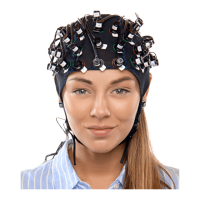NIRStar 14.1 - User Manual
Page 111 of 124
When ‘Laser Splitter Box’ is checked, the Number of Sources field under the Channel Setup tab will be
kept an even number i.e. each time the user increases or decreases the number of sources by clicking on
the corresponding arrow up or down, a pair of sources will be respectively added or removed from the
illumination pattern.
Because the Hyperscanning feature forbids splitting fiber bundles between subjects, in the case of using
the ‘splitter box’ option, the Hyperscanning feature is only available for even multiples of sixteen
sources.
When operating with bifurcated laser fibers, hyperscanning is available only if an even
multiple of four detectors and an even multiple of sixteen sources are available in the
system.
20.2 Saved files
For measurements performed with a 4-wavelength laser configuration, the signals are stored in four
separate files:
prefix-yyyy-mm-dd_xxx.wl1 ← contains data for wavelength 1 (685 nm)
prefix-yyyy-mm-dd_xxx.wl2 ← contains data for wavelength 2 (780 nm)
prefix-yyyy-mm-dd_xxx.wl3 ← contains data for wavelength 3 (808 nm)
prefix-yyyy-mm-dd_xxx.wl4 ← contains data for wavelength 4 (830 nm)
These data files contain the raw voltage readings recorded by the source-detector channels.
The file format is a space-separated ASCII table where columns represent data channels and rows
represents time frames. The file contains no header, explicit row or column labels, or time stamps. The
data structure for each file is identical to that outlined for regular (LED) illumination (see section Data
File Formats).
Figure 91. Example of saved data files after a measurement operated with laser.

